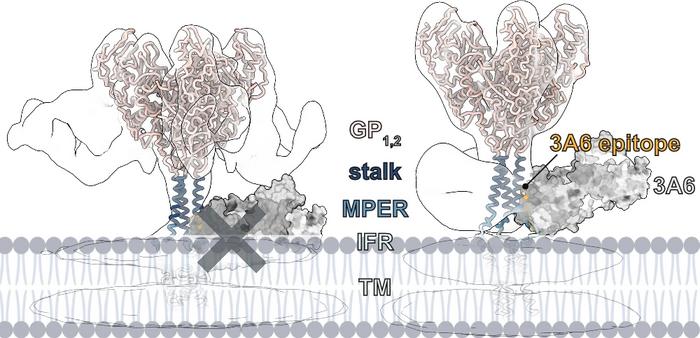
Groundbreaking Insights into mAb 3A6: A Potent New Antibody Against the Ebola Virus
Recent advancements in biomedical research have unveiled critical findings regarding a human antibody, known as mAb 3A6, which shows promise as a vital element in the therapeutic landscape for combating the Ebola virus. This revolutionary study led by scientists at the La Jolla Institute for Immunology (LJI) illuminates the sophisticated interplay between the antibody and the intricate structure of the Ebola virus. With the challenge posed by viral pathogens, the identification of such antibodies provides new hope in the race against viral diseases.
The research is anchored in a well-documented Ebola outbreak that transpired from 2014 to 2016 in West Africa. This epidemic resulted in a staggering loss of over 11,300 lives. The antibody mAb 3A6 emerged from the blood of an Ebola survivor treated at Emory University Hospital during this tragic crisis. By isolating and studying this antibody, the researchers have established a crucial understanding of its mechanism, lending insights that could alter therapeutic strategies.
What makes mAb 3A6 especially noteworthy is its ability to hinder infection through binding to a unique component of the Ebola virus’s architecture, identified as the “stalk.” The stalk is not merely a structural feature; it plays an essential role in the viral lifecycle, anchoring the virus’s glycoprotein to its membrane, enabling it to infiltrate host cells. Therefore, targeting this region can significantly impair the virus’s capacity to propagate and cause disease.
In the ensuing study, collaborators from the National Institute of Allergy and Infectious Diseases (NIAID) revealed that mAb 3A6 exhibits protective effects in non-human primates suffering from advanced stages of Ebola virus disease. This discovery represents a watershed moment in the understanding of antibody efficacy, particularly noting that mAb 3A6 offers robust protection at surprisingly low doses compared to existing treatments.
Professor Erica Ollmann Saphire, a leading investigator in this project, emphasizes the significance of low-dose efficacy for antibody therapies. Achieving effective outcomes with minimal quantities of antibodies could drastically streamline manufacturing processes, thereby reducing costs and making treatments more accessible in the face of infectious outbreaks. This stands as a beacon of hope for regions frequently affected by Ebola and similar viral threats.
The underlying mechanisms by which mAb 3A6 exerts its therapeutic effects are rooted in its affinity for the viral stalk region. The researchers employed advanced imaging techniques, including cryoelectron tomography and x-ray crystallography, to observe the intricate way mAb 3A6 interacts with the Ebola virus. Such imaging provides a visual representation of the binding process, highlighting how the antibody navigates the complex dynamic landscape of viral proteins.
Interestingly, the study uncovered that mAb 3A6 is capable of interacting with a site obscured by nuanced movements of viral proteins. This enhances the antibody’s binding capabilities, indicating a level of sophistication in its design. It capitalizes on the subtle “dance” of these proteins, slipping into concealed areas and effectively neutralizing the virus’s ability to infect.
The implications of these findings extend beyond immediate therapeutic applications. mAb 3A6 represents a promising avenue for developing “pan-Ebolavirus” therapeutics due to the highly conserved nature of the stalk region across different Ebola virus species. This realization could pave the way for universal vaccine strategies targeting this critical component of the virus and broaden the understanding of antibody interactions with other viral pathogens.
Further advancements in vaccine design may arise from this pivotal research. By illuminating the structural vulnerabilities of the Ebola virus through its focal interaction with mAb 3A6, scientists are now positioned to explore innovative ways to stimulate the immune system more effectively. The study’s first author, Dr. Kathryn Hastie, points out that such insights could inform the creation of tailored vaccines targeting the identified viral regions.
The comprehensive study manifests as a collaborative effort among eminent researchers, including individuals from Cambridge University, the Max Planck Institute, and various research institutes dedicated to the study of infectious diseases. This interdisciplinary approach underscores the collective commitment to understanding viral mechanisms, which is essential in the fight against global health threats.
Funding from numerous government and research agencies, including the National Institute of Health and the Defense Advanced Research Projects Agency (DARPA), has facilitated this critical research. Such investments highlight the imperative of prioritizing research on high-risk infectious diseases, particularly those that can lead to widespread outbreaks with devastating human and economic costs.
As the world grapples with emerging infectious diseases, the strategic development of treatments like mAb 3A6 can significantly influence public health responses. These findings not only enhance the immediate understanding of Ebola virus therapeutics but lay the groundwork for future innovations in viral medicine. The commitment to exploring the complexities of human antibodies in combating lethal viruses such as Ebola represents a vital frontier in medical research.
The future of antiviral strategies hinges on the ongoing exploration of our immune system’s capabilities, particularly through the lens of monoclonal antibodies like mAb 3A6. The lessons learned from this study serve as a reminder of the resilience of scientific inquiry, revealing pathways to breakthroughs that may one day protect vulnerable populations from the threat of viral disease.
In summary, the unveiling of mAb 3A6’s effectiveness in a low-dose therapeutic setting marks a significant development in antiviral research. As methods for targeting viral structures improve, the scientific community is poised to expand its arsenal against infectious diseases and transform public health outcomes across the globe.
Subject of Research: Antibody interaction with Ebola virus
Article Title: Groundbreaking Insights into mAb 3A6: A Potent New Antibody Against the Ebola Virus
News Publication Date: 17-Jan-2025
Web References:
References:
Image Credits: Saphire Lab, Nature Communications
Keywords: Ebola virus, Antibody therapy, Monoclonal antibodies, Vaccine research, Protein structure, Vaccine target, Nonhuman primates.
Tags: antibody isolation from survivorsbiomedical innovations in disease treatmentEbola outbreak 2014-2016Ebola virus researchhope in combating viral diseasesLa Jolla Institute for ImmunologymAb 3A6 antibodymechanisms of viral infectionpandemic preparedness strategiesstructural biology of Ebola virustherapeutic advancements in virologyviral pathogen challenges





